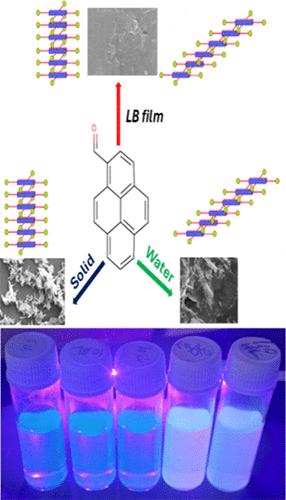从水溶液到Langmuir-Blodgett薄膜:调整准分子偶联聚集诱导的芘-1-甲醛的发射行为
IF 3.9
2区 化学
Q2 CHEMISTRY, MULTIDISCIPLINARY
引用次数: 0
摘要
聚集诱导的发射增强(AIE)研究是科学界特别感兴趣的,因为它连接了材料科学和分子科学。芘的衍生物因其优异的AIE性能而受到广泛的研究。然而,吡啶-1-甲醛(Py-CHO)是一种常用的构建芘的前体,尚未被广泛研究以探索其作为AIEgen的潜力,如果有的话。在目前的工作中,对Py-CHO在有机-水(THF:水)双相体系、固态和硬脂酸负载的Langmuir-Blodgett (LB)薄膜中的稳态和时间分辨光谱进行了全面的研究。Py-CHO在水中表现出明显的AIE效应,与有机溶剂THF相比,量子产率提高了10倍。发射寿命行为表明准分子和聚集体共存。通过时间分辨发射寿命的测量,比较了Py-CHO在水溶液中的聚集性质与固态(粉末)和硬脂酸负载LB膜中的聚集性质。在水溶液中,只形成H和J聚集体,而在固态和LB膜中,单体、准分子、J和H聚集体相互共存。目前的结果是重要的,因为它们可以作为指导,通过将相同的溶液从水溶液改变为粉末形式和LB膜来调整AIEgen中光学不同的聚集体,这可以具有多种光电应用。本文章由计算机程序翻译,如有差异,请以英文原文为准。

From Aqueous Solution to Langmuir–Blodgett Films: Tuning the Excimer-Coupled Aggregation-Induced Emission Behavior of Pyrene-1-carboxaldehyde
Aggregation-induced enhancement of emission (AIE) research is of particular interest to the scientific community, as it bridges material and molecular science. Derivatives of pyrene have been extensively studied for their remarkable AIE properties. However, pyrene-1-carboxaldehyde (Py-CHO), a frequently used precursor to construct pyrene, has not been studied extensively to explore its potential as an AIEgen, if any. In the current work, a comprehensive steady-state and time-resolved spectroscopic study on Py-CHO in an organic–water (THF:water) biphasic system, in a solid state, and in stearic acid-supported Langmuir–Blodgett (LB) films has been presented. Py-CHO shows a prominent AIE effect in water accompanied by a 10-fold quantum yield increment compared to organic solvent THF. The emission lifetime behavior was indicative of coexistence of excimer as well as aggregates. The aggregation nature of Py-CHO in aqueous solution was compared and contrasted to the same in the solid state (powder) and stearic acid-supported LB films with the aid of time-resolved emission lifetime measurements. It was observed that in aqueous solution, only H and J aggregates are formed, whereas in the solid state and LB films, mutual coexistence of monomer, excimer, and J and H aggregates was obtained. The current results are significant as they serve as a guideline to tune the optically differing aggregates in an AIEgen by changing the phase of the same from aqueous solution to powder form and in LB films, which can have multiple optoelectronic applications.
求助全文
通过发布文献求助,成功后即可免费获取论文全文。
去求助
来源期刊

Langmuir
化学-材料科学:综合
CiteScore
6.50
自引率
10.30%
发文量
1464
审稿时长
2.1 months
期刊介绍:
Langmuir is an interdisciplinary journal publishing articles in the following subject categories:
Colloids: surfactants and self-assembly, dispersions, emulsions, foams
Interfaces: adsorption, reactions, films, forces
Biological Interfaces: biocolloids, biomolecular and biomimetic materials
Materials: nano- and mesostructured materials, polymers, gels, liquid crystals
Electrochemistry: interfacial charge transfer, charge transport, electrocatalysis, electrokinetic phenomena, bioelectrochemistry
Devices and Applications: sensors, fluidics, patterning, catalysis, photonic crystals
However, when high-impact, original work is submitted that does not fit within the above categories, decisions to accept or decline such papers will be based on one criteria: What Would Irving Do?
Langmuir ranks #2 in citations out of 136 journals in the category of Physical Chemistry with 113,157 total citations. The journal received an Impact Factor of 4.384*.
This journal is also indexed in the categories of Materials Science (ranked #1) and Multidisciplinary Chemistry (ranked #5).
 求助内容:
求助内容: 应助结果提醒方式:
应助结果提醒方式:


